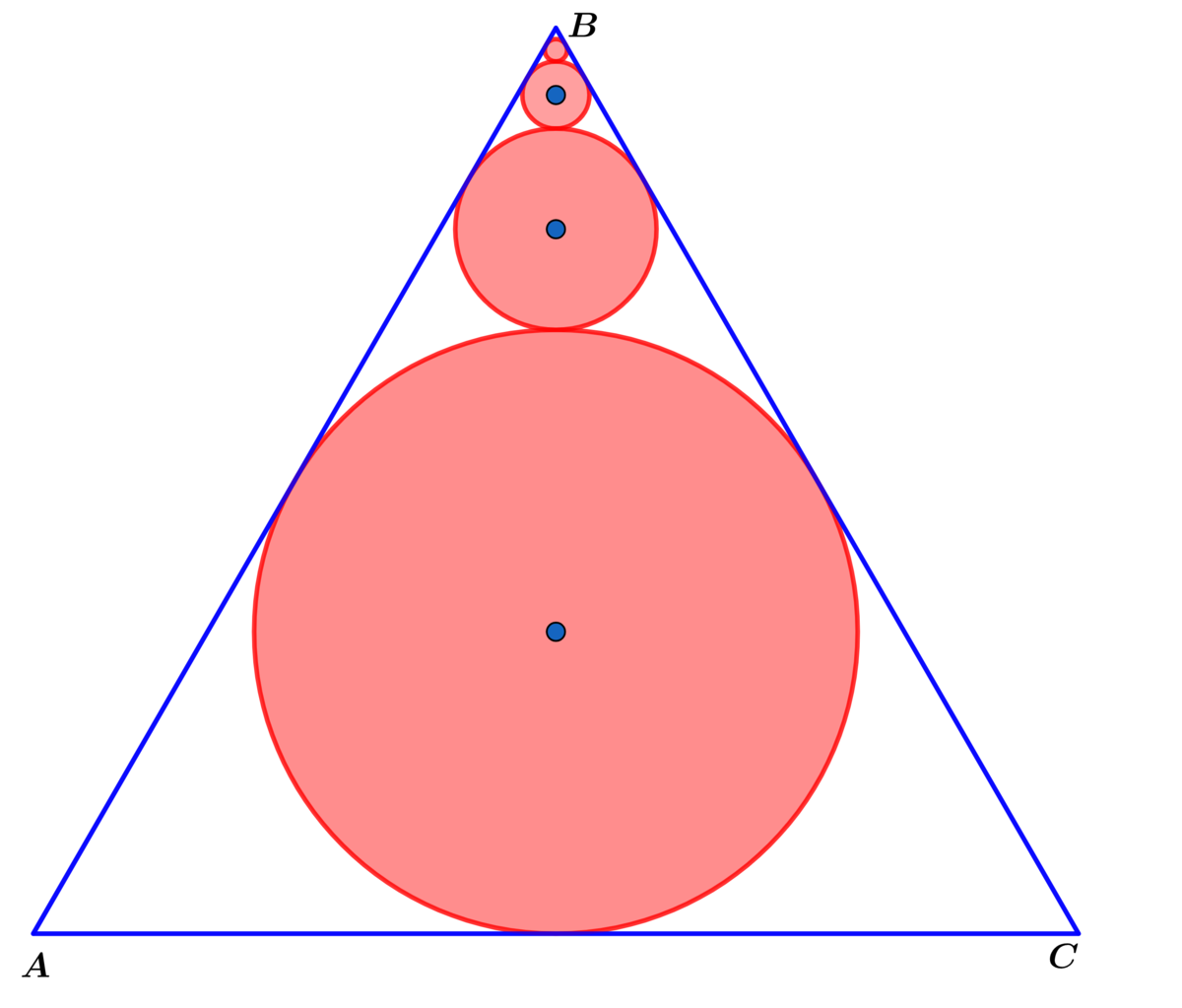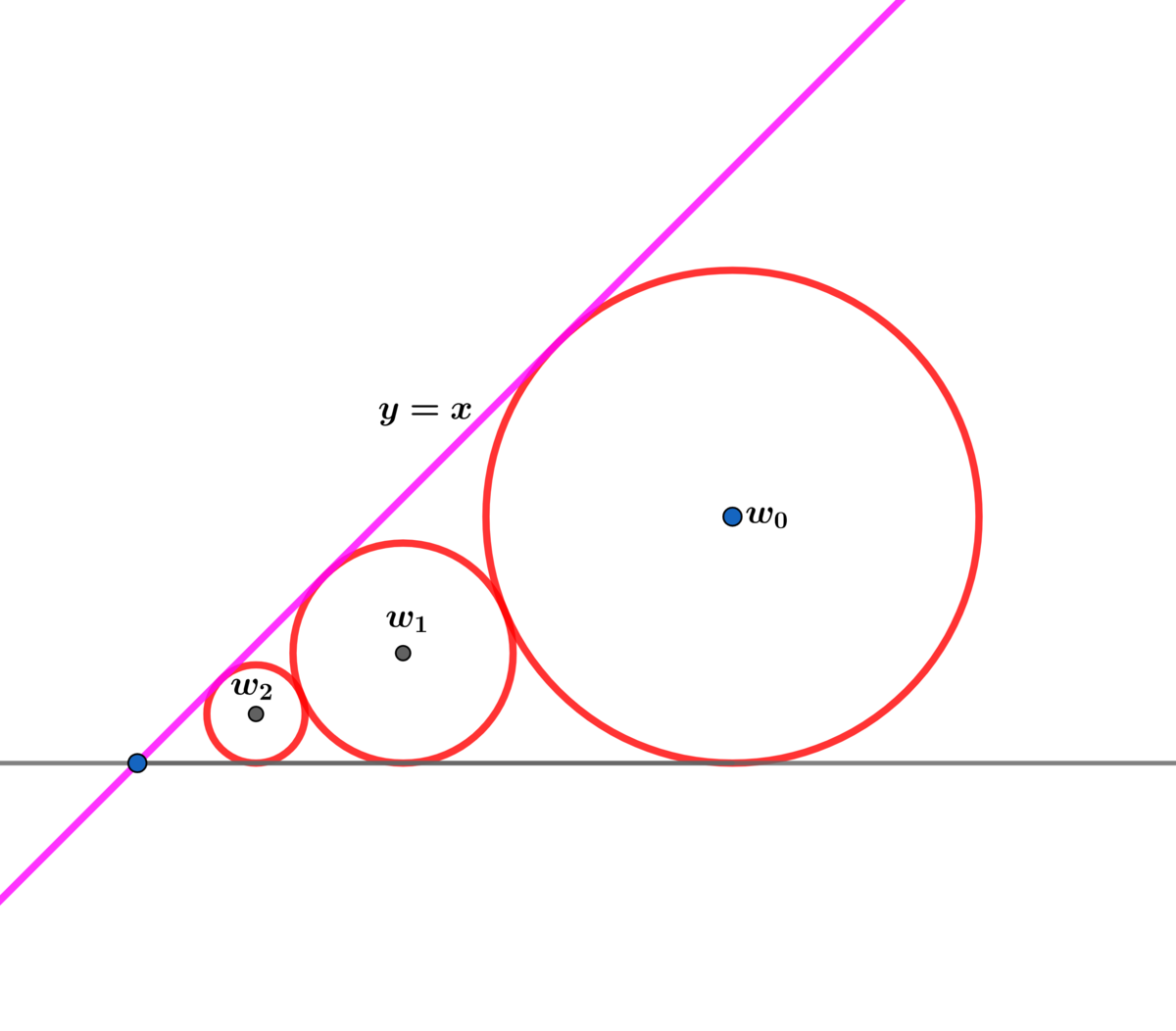More Circles!
Diagram 1:

Diagram 2:

Extend both diagrams above to an infinite number of circles.
(Diagram 1:) In equilateral , the largest circle is tangent to each side of and for circle is tangent to circle and to and .
Let be the total area of all the circles.
(Diagram 2:) For each integer , circle is tangent to and tangent to the line and the positive axis.
Let and be the total circumference and area of all the circles respectively.
If , where and are coprome positive integers, find .
The answer is 10.
This section requires Javascript.
You are seeing this because something didn't load right. We suggest you, (a) try
refreshing the page, (b) enabling javascript if it is disabled on your browser and,
finally, (c)
loading the
non-javascript version of this page
. We're sorry about the hassle.
Using the above diagram we obtain:
a 1 2 R 1 = tan ( 3 0 ∘ ) = 3 1 ⟹ R 1 = 2 3 a 1
and H 2 = H 1 − 2 R 1 = 2 3 a 1 − 3 1 a 1 = 2 3 a 1
H 2 H 1 = 3 = a 2 a 1 ⟹ a 2 = 3 a 3
a 2 2 R 2 = 3 1 ⟹ R 2 = 2 3 a 2 = 6 3 a 1
H 3 = H 2 − 2 R 2 = 2 3 a 1 − 3 3 a 1 = 1 8 3 a 1 = 6 3 a 1
H 3 H 2 = 3 = a 3 a 2 ⟹ a 3 = 3 a 2 = 9 a 1 ⟹
a 3 2 R 3 = 3 1 ⟹ R 3 = 2 3 a 3 = 1 8 3 a 1
In General:
R n = 2 3 a 1 ( 3 1 ) n − 1
Note: H n = 2 3 a 1 ( 3 1 ) n − 2
⟹ A n = π R n 2 = 1 2 π ( 9 1 ) n − 1 a 1 2
⟹ S = ∑ n = 1 ∞ A n = 1 2 π a 1 2 ( 8 9 ) = 3 2 3 π a 1 2 = 4 3 ( 8 3 π ( 3 1 ) a 1 2 = 8 3 3 π A △ A B C = 8 3 π A △ A B C
⟹ A △ A B C S = 8 3 π .
Note: I'm using the same notation R n in Diagram 2 to denote different radii.
O w 0 = 4 + 2 2 R 1
△ O A 1 w 0 ∼ △ w 1 A 2 w 0 ⟹ R 1 4 + 2 2 R 1 = R 1 − R 2 R 1 + R 2 ⟹
( 4 + 2 2 − 1 ) R 1 = ( 4 + 2 2 + 1 ) R 2 ⟹ R 2 = 4 + 2 2 + 1 4 + 2 2 − 1 R 1
R 3 = 4 + 2 2 + 1 4 + 2 2 − 1 R 2 = ( 4 + 2 2 + 1 4 + 2 2 − 1 ) 2 R 1
In General: R n = ( 4 + 2 2 + 1 4 + 2 2 − 1 ) n − 1 R 1
⟹ A n = π R n 2 = π R 1 2 ( ( 4 + 2 2 + 1 4 + 2 2 − 1 ) 2 ) n − 1
⟹ A = ∑ n = 1 ∞ A n = π R 1 2 ∑ n = 1 ∞ ( ( 4 + 2 2 + 1 4 + 2 2 − 1 ) 2 ) n − 1
= 4 4 + 2 2 ( 4 + 2 2 + 1 ) 2 π R 1 2
and
C n = 2 π R n = 2 π R 1 ( 4 + 2 2 + 1 4 + 2 2 − 1 ) n − 1
⟹ C = ∑ n = 1 ∞ C n = 2 π R 1 ∑ n = 1 ∞ ( 4 + 2 2 + 1 4 + 2 2 − 1 ) n − 1 =
( 4 + 2 2 ) π R 1 ⟹ C 2 = ( 4 + 2 2 ) 2 π 2 R 1 2
⟹ C 2 A = 4 π 4 + 2 2 1
⟹ A △ A B C S ∗ C 2 A = 2 5 2 2 + 2 2 3 = β λ β β + β β α ⟹
α + β + λ = 1 0 .